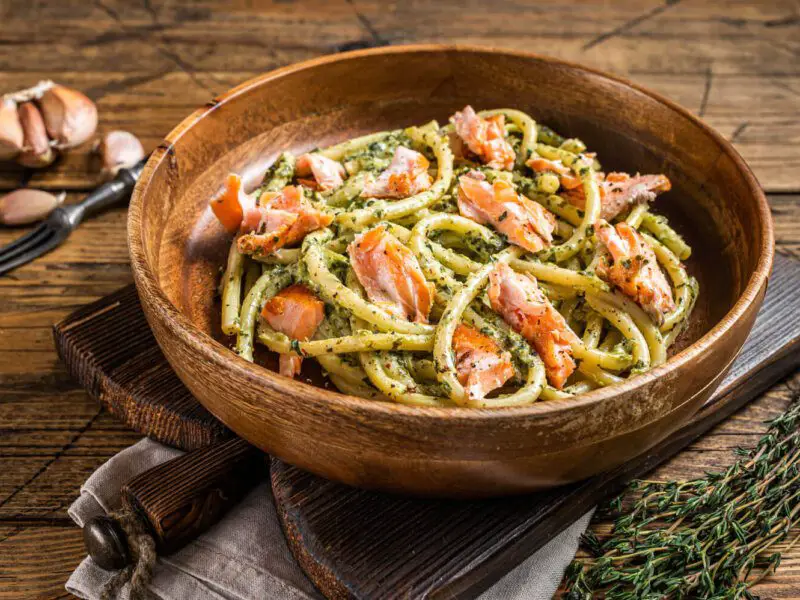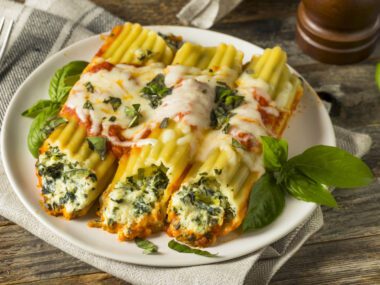When you stroll down the aisles of your local grocery store, you’re likely to be greeted by a kaleidoscope of pasta varieties. From the long and slender spaghetti to the curvy and ridged twists, there’s a pasta for every occasion. But what if I told you that some pasta has a secret – a hole right through the middle? That’s where we dive into the world of Perciatelli and Bucatini, two pasta types that often leave folks puzzled. Are they the same? Let’s uncover the pasta truth in this flavorful journey.
The Pasta Duo: Bucatini and Perciatelli
Imagine a pasta that’s like spaghetti but with a hidden twist. Bucatini and Perciatelli are essentially the yin and yang of the pasta universe, yet they’re as closely connected as two pasta strands in a pot of boiling water. Yes, they’re twins separated at birth and renamed in different regions of Italy.
- Bucatini: If you’re an Italian purist, you probably know it by its classic name, “Bucatini.” The name’s origins can be traced back to the Italian word “buco,” which means “hole.” And that’s precisely what makes Bucatini unique – it’s spaghetti-like in appearance but sports a tiny tunnel running through its center. It’s like the pasta version of a straw, but far more delicious.
- Perciatelli: Now, if you find yourself in the scenic region of Campania, Italy, you might hear a different name being whispered – “Perciatelli.” This moniker comes from an old French word, “perciato,” meaning “pierced.” It’s a nod to the hollow heart of this pasta, and it’s the name that folks in Campania prefer.
Diving into the Pasta Details
Before you start getting hungry and craving a big plate of Bucatini or Perciatelli, let’s get to know these pasta shapes a bit better.
- Appearance: Both Bucatini and Perciatelli have a cylindrical shape, akin to traditional spaghetti. They’re thicker, though, and they boast a hollow center that runs the entire length of the pasta. This central tunnel is where the magic happens, allowing these pasta varieties to stand out in the world of Italian cuisine.
- Ingredients: The dough for Bucatini or Perciatelli is crafted from hard durum wheat, flour, and water. It’s a simple yet perfect combination that yields a pasta that’s both chewy and delightful. Sometimes, the simplest things in life are the most satisfying.
- Manufacturing: Bucatini or Perciatelli is an extruded pasta. This means it’s made with a machine that pushes the pasta dough through a disk with tiny circular perforations, forming that signature hollow core. The result is a pasta that’s as fun to eat as it is to pronounce.
- Size: These pasta varieties are typically about 25 to 30 centimeters (10-12 inches) in length and have a diameter of around 3 millimeters. They’re not too big, not too small, just the perfect size to twirl around your fork.
Using Bucatini or Perciatelli
Now that you’ve met Bucatini and Perciatelli, it’s time to understand how to use them in your culinary adventures.
- Cooking: To prepare Bucatini or Perciatelli, simply boil them for about ten minutes until they’re tender. The hollow center of these pasta shapes provides a greater surface area, which helps sauces cling to them perfectly.
- Sauce Pairings: Bucatini or Perciatelli is the ideal partner for thick, rich sauces. Traditional Italian favorites like tomato sauces and bolognese sauce complement these pasta types brilliantly. The hollow center acts as a saucy reservoir, making each bite burst with flavor.
- Pasta Variations: A simple butter dressing can also work wonders with Bucatini or Perciatelli, giving you a taste of the simpler side of Italian cuisine.
- Amatriciana Magic: One of the most famous dishes featuring these pasta shapes is “Perciatelli or Bucatini all’ Amatriciana.” This mouthwatering creation involves a sauce made from tomatoes, guanciale, and pecorino Romano cheese. It’s a true Italian delight that’ll have you savoring every bite.
- Beyond the Plate: While these pasta varieties are often the stars of the show, they’re versatile enough to be used in casseroles or served in soups. Classic Italian soups like minestrone can be given a delightful twist with the addition of Bucatini or Perciatelli.
Substituting Bucatini or Perciatelli
In some recipes that call for spaghetti, you can confidently substitute Bucatini or Perciatelli. They have a similar texture and shape, making them the perfect stand-ins for those classic Italian recipes you adore.
Going Green with Pasta
Here’s a surprising fact: Bucatini or Perciatelli can also play a role in saving the planet. They can be used as biodegradable drinking straws. Imagine sipping your favorite beverage through a pasta straw – not only delicious but environmentally friendly too!
In Conclusion: Bucatini, Perciatelli – A Pasta by Any Other Name
So, is Perciatelli the same as Bucatini? In a culinary sense, absolutely! They’re like pasta siblings, each with a unique name depending on where you find them in Italy. The hollow center, the rich texture, and the ability to pair with a variety of sauces make them a must-try for any pasta enthusiast.
Whether you call it Bucatini or Perciatelli, these pasta varieties are a true Italian treasure. So, next time you’re at the grocery store, keep an eye out for these delightful pasta twists. They may just become your new favorite ingredient in the kitchen. Bon appétit!



